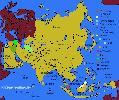|
|
|
|
|
|
|
|
|
|
|
|
|
|
| | |
|
|
|
|
| | |
| Name | latin |
Odontomantis micans |
| english |
Ant Mantis |
| |
|
| Systematics
Systematics
|
|
All data for the systematics is taken from Reinhard Ehrmann's book "Mantodea - Gottesanbeterinnen der Welt" (Mantodea - Praying mantids of the world).
More about this book can be found in the section literature at this page.
|

|

| Super-Order |
Dictyoptera |
| Order |
Mantodea |
| Family |
Hymenopodidae |
| Subfamily |
Acromantinae |
| Tribe |
Acromantini |
| |
|
| | First Description | Author |
SAUSSURE |
| Year |
1871 |
| |
|
| Size
Quotation of Size
|
|
The given size is measured from the head to the end of the abdomen, without the wings.
|

|

| Male |
ca. 1,5cm |
| Female |
ca. 2,4cm |
| |
|
| Lifespan
Quotation of the Lifespan
|
|
The lifespan is given in month and has the following definition:
overall-age ("time between hatching and imago" + "lifespan after the last molting")
Example: 9 (2 + 7) month lifespan
overall-age = 9 month
time between hatching and imago = 2 month
lifespan after the last molting = 7 month
|

|

| Male |
ca. 5 (2,5 + 2,5) months / ~ 6 moltings |
| Female |
ca. 6,5 (2,5 + 4) months / ~ 7 moltings |
| |
|
| Sexing
Sexing
|
|
Morphologically differences between male and female.
|

|

| Male |
L5 and above: just by counting the abdominal- segments (8 Segments)
adult: smaller and thinner than females, otherwise by counting the abdominal- segments |
| Female |
L5 and above: just by counting the abdominal- segments (6 Segments)
adult: bigger and more compact than females, otherwise by counting the abdominal- segments |
| |
|
| | | | Spreading
Spreading
|
|
For a better overview, only whole countries are listed for the quotation of spreading, even if a species can only be found in a small part of that country.
All data for the spreading is taken from Reinhard Ehrmann's book "Mantodea - Gottesanbeterinnen der Welt" (Mantodea - Praying mantids of the world).
More about this book can be found in the section literature at this page.
At the menu "Spreading" for each country only the genus but the species is printed (Exception: on this site described species).
|

|

| India, Sri Lanka, Thailand, Sumatra, Borneo, Sunda Islands |
| The description of this species is based on individuals of the following origin:
Pak-Chong (Thailand) |
| |
| |
|
| |
 |
| Asia |
|
| | Habitat | bushes
inhabits damp and warm areas |
| |
|
| | Aggressiveness | low |
| |
|
| | Colorvariants | none |
| |
|
| | Hint | mimics ants in look and behaviour perfectly,
take care for good ventilation and no stagnant moisture |
| |
|
|
| |
|
|
|
|
|
|
|
|
|

